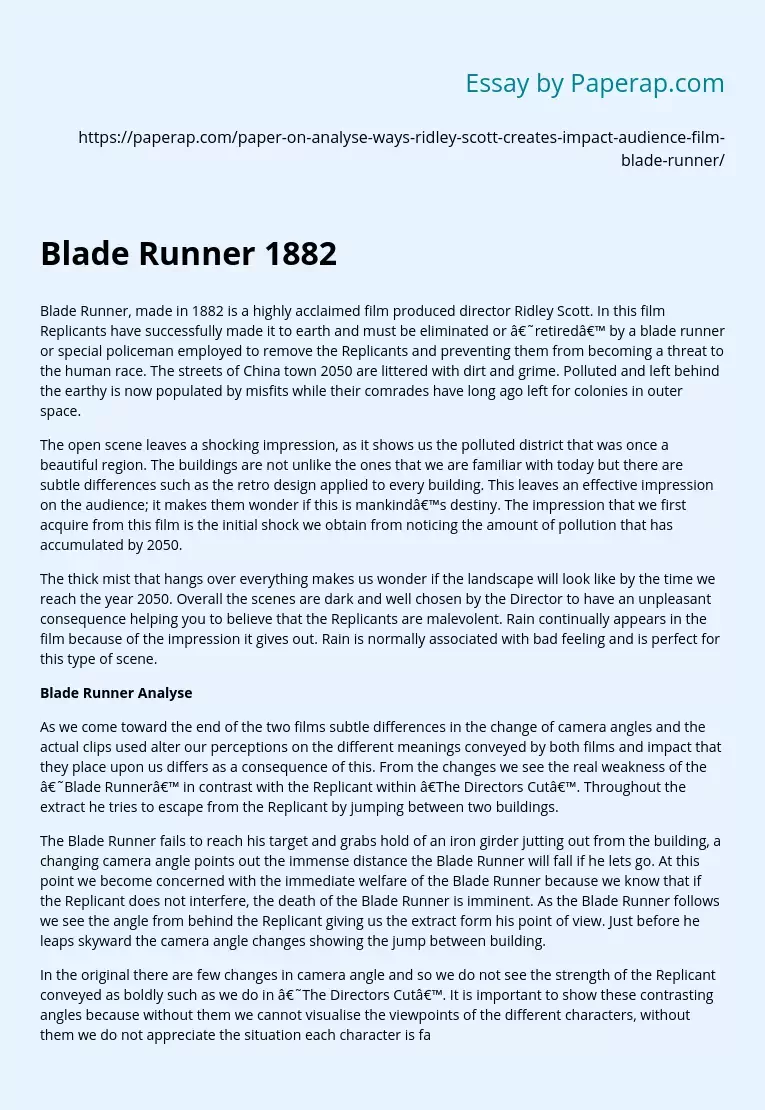Blade Runner Analyse 1882
Blade Runner, made in 1882 is a highly acclaimed film produced director Ridley Scott. In this film Replicants have successfully made it to earth and must be eliminated or ‘retired’ by a blade runner or special policeman employed to remove the Replicants and preventing them from becoming a threat to the human race. The streets of China town 2050 are littered with dirt and grime. Polluted and left behind the earthy is now populated by misfits while their comrades have long ago left for colonies in outer space.
The open scene leaves a shocking impression, as it shows us the polluted district that was once a beautiful region. The buildings are not unlike the ones that we are familiar with today but there are subtle differences such as the retro design applied to every building. This leaves an effective impression on the audience; it makes them wonder if this is mankind’s destiny. The impression that we first acquire from this film is the initial shock we obtain from noticing the amount of pollution that has accumulated by 2050.
The thick mist that hangs over everything makes us wonder if the landscape will look like by the time we reach the year 2050. Overall the scenes are dark and well chosen by the Director to have an unpleasant consequence helping you to believe that the Replicants are malevolent. Rain continually appears in the film because of the impression it gives out. Rain is normally associated with bad feeling and is perfect for this type of scene.
As we come toward the end of the two films subtle differences in the change of camera angles and the actual clips used alter our perceptions on the different meanings conveyed by both films and impact that they place upon us differs as a consequence of this. From the changes we see the real weakness of the ‘Blade Runner’ in contrast with the Replicant within ”The Directors Cut’. Throughout the extract he tries to escape from the Replicant by jumping between two buildings.
The Blade Runner fails to reach his target and grabs hold of an iron girder jutting out from the building, a changing camera angle points out the immense distance the Blade Runner will fall if he lets go. At this point we become concerned with the immediate welfare of the Blade Runner because we know that if the Replicant does not interfere, the death of the Blade Runner is imminent. As the Blade Runner follows we see the angle from behind the Replicant giving us the extract form his point of view. Just before he leaps skyward the camera angle changes showing the jump between building.
In the original there are few changes in camera angle and so we do not see the strength of the Replicant conveyed as boldly such as we do in ‘The Directors Cut’. It is important to show these contrasting angles because without them we cannot visualise the viewpoints of the different characters, without them we do not appreciate the situation each character is facing. This shows the difference between the original film and director’s cut and so differs our perception The improved camera angles in ‘The Directors Cut’ bring out a more vivid picture overwhelming strength of the Replicant.
After the death of the Replicant the two films return to the apartment of the Blade Runner. He finds his lover and makes it out safely with her. On the balcony out side the apartment an origami unicorn is left lying on the cold concrete floor. It is here that the main change between Cut and Original can be noticed; in the Original the Blade Runner places the unicorn on the dashboard of the hover police car and we see it fly into the distance.
However in ”The Directors Cut” the drive away scene featured in the original film is omitted. This is a notable difference as it alters our perception of the film entirely. It is this that sets aside the lasting impression we receive whilst conveying different messages, ‘The Directors Cut’ leaves a subtle hint which points out that although is a Replicant she will live for much longer than previous Replicant models allowing her to stay with the Blade Runner for the remainder of their lives.
The deduction of the drive away scene in ‘The Directors Cut’ removes the sense that the two characters will live happily ever after and although will have a prolonged life the couples immediate future is still uncertain. The differences between the two endings of ‘Blade Runner’ and ‘The Directors Cut’ signals the main change in viewpoint over the two films and the impact they have on their audiences.
The removal of the drive away scene leads us to believe that the characters futures are still uncertain and that they may not live happily ever after as the original ‘Blade Runner’ film depicts. The altered camera angles in ‘The Directors Cut’ give us a better perspective of the individual characters points of view. All of the changes made in the 1991 ‘The Directors Cut’ vary our opinion of the true meaning of the film ‘Blade Runner’, the impact the film has an the spectators also changes noticeably as the transformations become more apparent to the viewers.
Blade Runner Analyse 1882. (2019, Dec 05). Retrieved from https://paperap.com/paper-on-analyse-ways-ridley-scott-creates-impact-audience-film-blade-runner/

